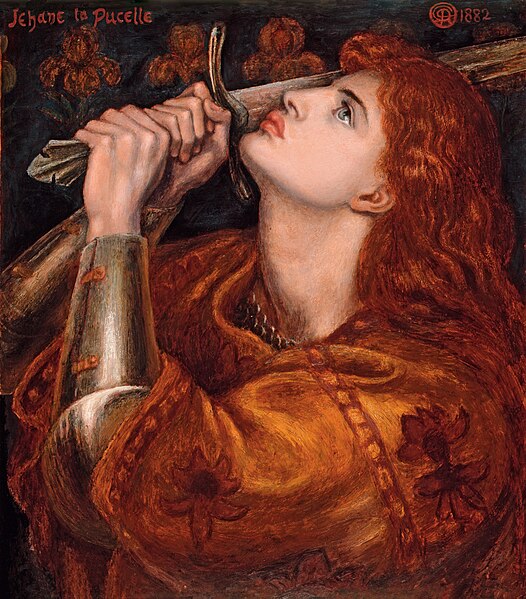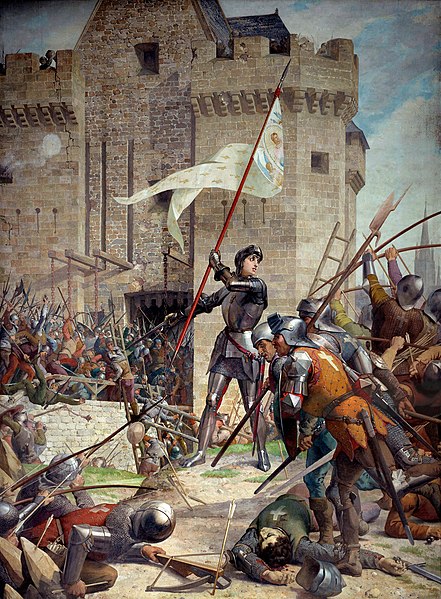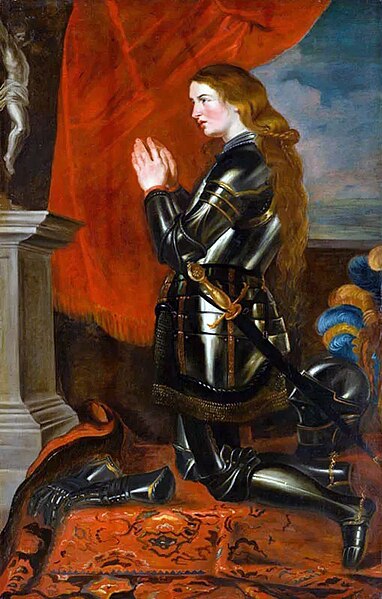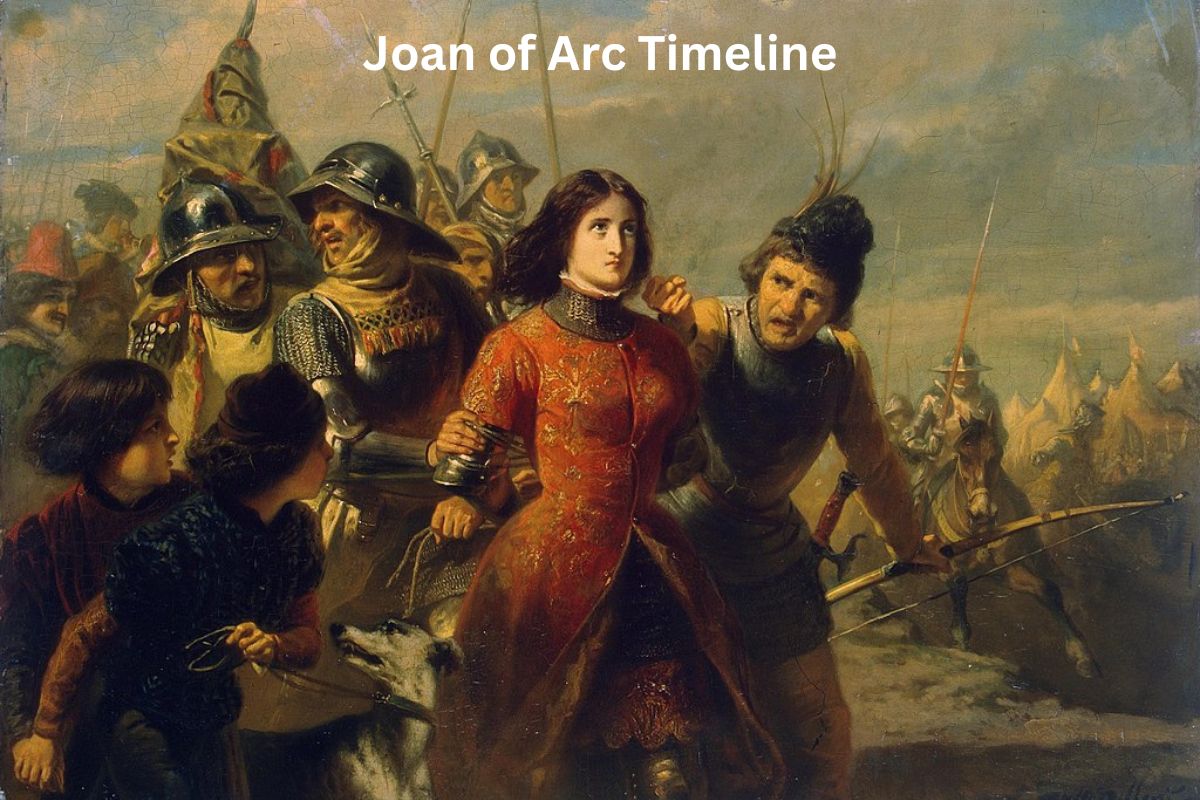Joan of Arc, also known as Jeanne d’Arc, was a remarkable figure in medieval France.
Born in 1412 in the village of Domrémy, she claimed to have received divine guidance from saints, which led her to play a pivotal role in the Hundred Years’ War between France and England.
Her extraordinary journey included leading French troops to key victories, convincing the dauphin Charles VII to be crowned king, and ultimately facing a tragic fate at the hands of her enemies.
Joan of Arc’s unwavering faith, courage, and military leadership continue to inspire people worldwide, and she remains a symbol of France’s resilience and devotion.
| Year | Event |
|---|---|
| 1412 | Joan of Arc is born in Domrémy, France. |
| 1425 | Joan begins hearing voices of saints. |
| 1429 | Joan meets with Robert de Baudricourt. |
| January 1429 | Joan travels to Chinon and meets Charles VII. |
| April 29, 1429 | Joan leads the French army to victory at the Siege of Orléans. |
| May 8, 1429 | Joan enters Orléans after the siege. |
| June 1429 | Joan accompanies Charles VII to Reims for his coronation. |
| September 8, 1429 | Joan’s attempt to capture Paris fails. |
| May 23, 1430 | Joan is captured by the Burgundians at Compiègne. |
| January 3, 1431 | Joan is sold to the English and imprisoned in Rouen. |
| February 21, 1431 | Joan goes on trial for heresy in Rouen. |
| May 30, 1431 | Joan is found guilty and sentenced to death. |
| May 31, 1431 | Joan is executed by burning at the stake. |
| 1456 | Joan is posthumously declared innocent by the Catholic Church. |
| 1909 | Joan is beatified by the Catholic Church. |
| 1920 | Joan is canonized as a saint by Pope Benedict XV. |
Timeline of Joan of Arc
1412 – Joan of Arc is born in Domrémy, France
Joan of Arc, originally named Jeanne d’Arc, was born in the year 1412 in the picturesque village of Domrémy, nestled within the northeastern regions of France.
Also Read: Facts About Joan of Arc
Her birthplace, a rural and tranquil setting, would become an essential backdrop to her extraordinary life.

1425 – Joan begins hearing voices and having visions
At the tender age of thirteen, in the year 1425, Joan’s life took a remarkable and mystical turn. She began experiencing visions and hearing voices that she fervently believed were of divine origin.
These celestial encounters involved communications with saints, notably Saint Michael, Saint Catherine, and Saint Margaret. These spiritual experiences were not fleeting or sporadic but consistent and persuasive, imbuing Joan with a profound sense of purpose and calling.
1429 – Joan meets with Robert de Baudricourt
In 1429, Joan decided to act on the divine guidance she had received. Her mission was to aid the dauphin of France, Charles VII, and help him regain the French throne from English control during the tumultuous period of the Hundred Years’ War.
Also Read: Accomplishments of Joan of Arc
Joan’s first significant step was to travel to the nearby town of Vaucouleurs to seek support for her mission. There, she met with Robert de Baudricourt, a local military commander. At first, her plea to Baudricourt to provide her with an escort and resources for her journey to see Charles VII was met with skepticism.
However, her unwavering determination eventually convinced Baudricourt to provide her with the support she needed, marking the beginning of her incredible journey and her role in shaping the course of history.
January 1429 – Joan travels to Chinon to meet Charles VII
In January of 1429, Joan embarked on a daring and arduous journey to Chinon, where she sought an audience with the dauphin, Charles VII.
Her mission was to convince him of her divine calling and to persuade him to grant her the resources and authority to lead French forces in the ongoing Hundred Years’ War.
This journey was not without its challenges, as it took her through treacherous territory and required her to navigate complex political landscapes.
April 29, 1429 – Joan leads French forces at the Siege of Orléans
One of the most pivotal moments in Joan’s life occurred on April 29, 1429, when she led the French army to the Siege of Orléans. The city had been under a protracted English siege, and its capture was of strategic importance.
Joan’s inspirational leadership and her unwavering belief in her divine mission motivated the French troops to achieve a significant victory over the English forces, lifting the siege and boosting French morale.

May 8, 1429 – Joan enters Orléans, ending the siege
Just days after their victory at the Siege of Orléans, on May 8, 1429, Joan and her forces entered Orléans. This marked a triumphant moment as they had not only broken the siege but had also secured control of a strategic city.
Joan’s military prowess and her reputation as a spiritual leader were on full display, solidifying her status as a symbol of hope and inspiration for the French people.
June 1429 – Joan accompanies Charles VII to Reims for his coronation
Joan’s successes continued as she accompanied Charles VII to Reims in June of 1429. At Reims, Charles was crowned as King of France. This was a momentous occasion, as it symbolized the fulfillment of Joan’s divine mission and the restoration of French sovereignty. Her role in Charles’s coronation further established her as a pivotal figure in French history.
September 8, 1429 – Joan’s attempt to capture Paris fails
Despite her string of successes, Joan faced challenges as well. In September of 1429, her attempt to capture Paris on behalf of Charles VII failed. The French forces were unable to take the city, and Joan was injured during the assault.
This setback demonstrated the complexities of the Hundred Years’ War and the formidable nature of her mission. However, Joan’s determination and resilience remained undiminished, and her legacy continued to grow.
May 23, 1430 – Joan is captured by the Burgundians
Tragedy struck in May of 1430 when Joan of Arc was captured by the Burgundians while she was defending the city of Compiègne. Her imprisonment marked a significant turning point in her life, as it placed her under the control of her enemies.
January 3, 1431 – Joan is sold to the English and imprisoned
Joan’s captivity took a darker turn on January 3, 1431, when she was sold to the English by her Burgundian captors. She was subsequently imprisoned in Rouen, a city held by the English during the conflict.
February 21, 1431 – Joan goes on trial for heresy in Rouen
In Rouen, Joan faced a trial that would become one of the most famous events in her life. On February 21, 1431, her trial for heresy and other charges began.
The proceedings were orchestrated by the English, and Joan’s captors sought to discredit her divine claims and her role in the French victories.

May 30, 1431 – Joan is found guilty and sentenced to death
On May 30, 1431, Joan of Arc was found guilty of heresy and other charges by the ecclesiastical court in Rouen. The verdict was a devastating blow, and it paved the way for her sentencing.
May 31, 1431 – Joan is executed by burning at the stake
On May 31, 1431, Joan of Arc was executed by burning at the stake in Rouen. Her execution was a brutal and tragic end to her remarkable journey. However, her indomitable spirit and unwavering faith in her divine mission left an enduring legacy.
1456 – Joan is posthumously declared innocent by the Catholic Church
In 1456, a quarter of a century after her execution, the Catholic Church reopened Joan of Arc’s case. She was posthumously declared innocent of heresy and other charges. This recognition affirmed the authenticity of her divine visions and her righteous cause.
1909 – Joan is beatified by the Catholic Church
In 1909, Joan of Arc achieved a significant milestone in her path to sainthood when she was beatified by the Catholic Church. Beatification is the second step in the process of canonization, which is the official recognition of an individual as a saint within the Catholic faith.
Beatification is typically the result of a thorough investigation into the person’s life, virtues, and any miracles attributed to their intercession. In Joan of Arc’s case, her beatification was a recognition of her exceptional virtues, unwavering faith, and the profound impact she had on the history of France.
The process of beatification for Joan of Arc involved a formal declaration by the Church that she had lived a life of heroic virtue. This declaration acknowledged her as a model of Christian virtues, making her a candidate for sainthood.
1920 – Joan is canonized as a saint by Pope Benedict XV
In 1920, Joan of Arc reached the pinnacle of recognition within the Catholic Church when she was officially canonized as a saint. Canonization is the highest honor bestowed by the Catholic Church, signifying that an individual is a saint and worthy of veneration by the faithful worldwide.
On May 16, 1920, Pope Benedict XV officially canonized Joan of Arc as a saint. This act affirmed her sanctity and her enduring significance in the eyes of the Catholic Church. Her canonization not only recognized her as a holy figure but also elevated her to the status of a role model for Catholics worldwide.
Joan of Arc’s canonization remains a powerful symbol of faith, courage, and devotion. She is celebrated not only within the Catholic Church but also in history and popular culture as an iconic figure who stood unwaveringly for her beliefs and left an indelible mark on the world.
